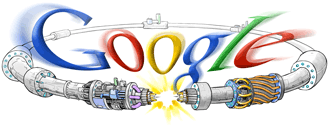 Large Hadron Collider, built by CERN at Franco-Swiss border, started circulating its first beam on September 10th. It earned world-wide coverage and Google even dedicated a logo to the day (left). However, what made the event famous is not the fact that it is the highest energy particle accelerator in the world, but the controversy that the energy could create vacuum bubbles that expand in light speed and bring the world to the end. I was first introduced by this idea when I was in high school, through the book “The Last Three Minutes” by Paul Davies. It was translated by 方励之, who was also a controversial figure at that time of China. Here is the excerpt in chapter “Sudden Death – and Rebirth” from the book:
Large Hadron Collider, built by CERN at Franco-Swiss border, started circulating its first beam on September 10th. It earned world-wide coverage and Google even dedicated a logo to the day (left). However, what made the event famous is not the fact that it is the highest energy particle accelerator in the world, but the controversy that the energy could create vacuum bubbles that expand in light speed and bring the world to the end. I was first introduced by this idea when I was in high school, through the book “The Last Three Minutes” by Paul Davies. It was translated by 方励之, who was also a controversial figure at that time of China. Here is the excerpt in chapter “Sudden Death – and Rebirth” from the book:
The worry is that the very high-energy collision of subatomic particles might create conditions – just for an instant, in a very small region of space – which would encourage the vacuum to decay. Once the transition had occurred, even on a microscopic scale, there would be no stopping the newly formed bubble from rapidly ballooning to astronomical proportions.
The book actually gives the exactly same answer as the LHC safety review committee:
… cosmic rays achieve higher energies than we can make inside our particle accelerators, and that these cosmic rays have been hitting nuclei in the Earth’s atmosphere for billions of years without triggering vacuum decay. … The real issue, however, is not whether bubble formation could occur on Earth but whether it has occurred anywhere in the observable universe at any time since the big bang. …
It’s funny while listening to LHC countdown, a voice of one scientist, “Five, Four, Three, Two, One, Zero, Nothing. OK.”